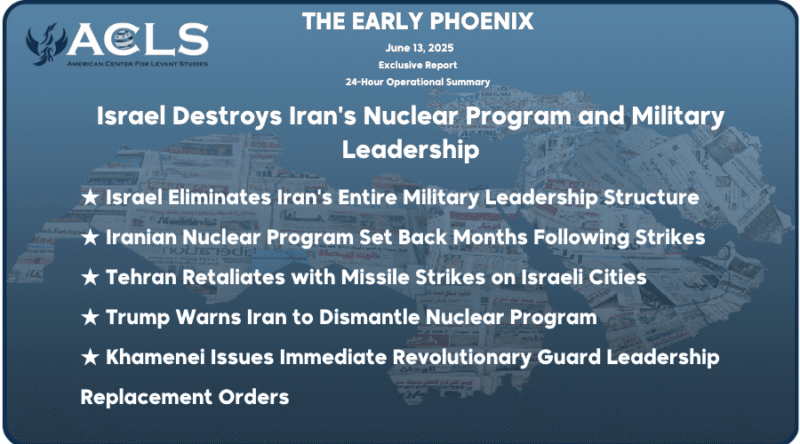
BOTTOM LINE UP FRONT:
Israel eliminated Iran’s entire military leadership and destroyed key nuclear facilities during early hours of June 13 local time. Tehran retaliated with missile strikes against Israeli cities. Iranian proxies failed to activate despite Tehran’s calls for regional response. President Trump issued an ultimatum demanding Tehran accept the nuclear deal or face escalating devastation: “Two months ago I gave Iran a 60-day ultimatum to ‘make a deal.’ Today is day 61. Now they have, perhaps, a second chance!”
EXECUTIVE SUMMARY:
Israel executed its largest-ever military operation against Iran, eliminating Iranian nuclear and military leadership while setting back Tehran’s nuclear program by months. Iran’s retaliatory strikes injured 41 Israelis. Iran’s proxy militant groups are not participating in the confrontation thus far. Iran withdrew from the June 15 nuclear talks in Muscat, Oman following Israeli strikes. Oil prices surged 8.5% with Brent crude reaching $75.38 per barrel. President Trump received calls from Saudi Crown Prince Mohammed bin Salman and Qatari Emir Sheikh Tamim bin Hamad Al Thani expressing concern about escalation.
OPERATIONAL TIMELINE:
-
Israel Declares Emergency, Prepares For Iranian Retaliation
Israel imposed nationwide emergency and closed airspace following strikes on Iran’s nuclear and military sites. Citizens ordered shelters as defense officials warned of imminent Iranian missile barrage. IDF sealed West Bank cities, mobilized reserves, fortified border areas against terror attacks. Israeli embassies worldwide activated crisis protocols. Tel Aviv Pride Parade canceled, education and transport halted. Airlines diverted flights after Israel, Iran, Iraq, Jordan closed airspace.
-
Explosions Rock Tehran Military Compounds, Strike Senior Command Centers
Over 200 Israeli aircraft struck 100+ sites across Iran including nuclear facilities and military command centers. Mossad pre-positioned explosive drone facilities inside Iran before Operation Rising Lion, exposing significant Israeli penetration of Iranian military infrastructure. Israeli commandos deployed precision weapons near missile sites targeting air defenses. Mossad networks infiltrated drone facilities that activated during strikes against Revolutionary Guard missile launchers at Esfejabad base near Tehran through extensive clandestine deployment. Coordinated systems received activation signals with Israeli Air Force strikes, firing precision missiles simultaneously. Mossad conducted three operations crippling Iran’s missile systems by sabotaging transport convoys, disabling IRGC aerospace communications, and striking Espadabad missile bases. Notable casualties include IRGC Commander Hossein Salami, Armed Forces Chief Mohammad Bagheri, General Gholam Ali Rashid, and General Amir Ali Hajizadeh. Several senior nuclear scientists killed, senior advisor Ali Shamkhani critically wounded. Israeli airstrikes damaged centrifuges at Natanz and destroyed Tabriz Military Airport, with three confirmed deaths. Iran reported no radiation leaks or damage at its Bushehr, Isfahan, or Fordow sites. Iran launched 100+ drones toward Israel in retaliation. Israel intercepted about 100 projectiles, with further interceptions reported over Syria. Secretary Rubio confirmed justified strikes as Israeli self-defense while warning Iran against targeting American personnel. Netanyahu declared Operation Rising Lion “will continue for as many days as it takes to remove this threat” and warned Iran plans ten thousand ballistic missiles within three years. Netanyahu described the potential impact as “ten thousand tons of TNT landing on a country the size of New Jersey” and emphasized “we can’t leave these threats for the next generation, because if we don’t act now, there will not be another generation.”
-
Iranian Missile Barrage Does Limited Damage to Israel
Iran executed “Operation Severe Punishment” through four missile phases targeting Israeli population centers. Tehran launched approximately 250 ballistic missiles across multiple waves beginning Friday evening. U.S. ground-based systems assisted Israeli interception efforts. Iran’s initial drone saturation involved over 100 Shahed drones intercepted over Syrian and Saudi airspace. Primary ballistic barrage featured two coordinated salvos totaling fewer than 100 missiles targeting Tel Aviv. Nine direct impacts struck residential buildings in Ramat Gan and central Tel Aviv, wounding 41 Israelis. Secondary waves launched dozens of additional missiles hours later with seven impact sites across central Israel. Saturday morning continuation targeted Israeli military infrastructure, killing one civilian and wounding seven others. Iranian ballistic performance demonstrated degraded precision against Israeli defense architecture. Tehran’s inability to overwhelm Iron Dome systems exposed critical missile guidance weaknesses and failed saturation tactics.
-
Israeli Strikes Cripple Iran
Israel’s Operation Rising Lion eliminated Iran’s entire military command structure including IRGC Commander Hossein Salami, Armed Forces Chief Mohammad Bagheri, and General Amir Ali Hajizadeh alongside six senior nuclear scientists. Israeli forces destroyed Natanz’s enrichment facilities and systematically eliminated air defense arrays and missile production facilities. Iranian retaliation through Operation Severe Punishment launched 250 ballistic missiles across four phases but killed only one Israeli civilian and wounded 64 others with localized infrastructure damage. Iran’s inability to overwhelm Israeli defense systems exposed critical guidance weaknesses and tactical failures. The asymmetric damage profile demonstrates Israeli operational superiority versus Iran’s crude bombardment tactics, revealing Tehran’s diminished deterrent posture following systematic military decapitation and nuclear program disruption.
============
DAMAGE ASSESSMENT DETAILED (IRAN):
- Nuclear Facilities Targeted:
Israel’s Operation Rising Lion achieved significant nuclear infrastructure damage using over 200 fighter jets and 330 munitions. The above-ground pilot enrichment plant at Natanz has been destroyed, with Israeli Air Force strikes destroying the underground section of the site, which housed “a multi-level enrichment hall housing centrifuges, electrical rooms, and other supporting infrastructure”. The International Atomic Energy Agency confirmed significant damage to Iran’s largest uranium enrichment facility. The Fordow fuel enrichment plant, the nuclear research site at Isfahan and the Bushehr nuclear power plant were not impacted, though explosions were reported near Fordow during continued Israeli operations Friday night.
- Military Infrastructure Devastation:
Israel systematically eliminated Iran’s top military leadership including IRGC Commander Hossein Salami, Armed Forces Chief Mohammad Bagheri, and General Amir Ali Hajizadeh. Multiple missile production facilities in Kermanshah were struck, with significant damage to underground missile infrastructure. Israeli fighter jets had also completed a “large-scale strike” on aerial defense arrays in western Iran, destroying dozens of radars and surface-to-air missile launchers.
- Tehran Infrastructure Damage:
At least five residential buildings in Tehran appear to have been damaged by Israeli strikes in targeted assassination operations. The Asatid-e Sarv Complex, Shahid Chamran Town, Narmak, Sattar Khan and Marzdaran neighborhoods sustained direct hits. Fire and heavy smoke billowed from Mehrabad Airport in the Iranian capital early Saturday with reports of projectiles hitting the military airbase section.
- Casualty Assessment:
Fars News Agency reported that at least 78 people have been killed and another 329 were injured during Israel’s attacks on 13 June. Six senior nuclear scientists were eliminated including Mohammad Mehdi Tehranchi and Fereydoon Abbasi. Iran’s entire military command structure was decapitated, forcing immediate replacement of all senior commanders.
- Iranian Retaliation Damage:
Iran’s retaliatory “Operation Severe Punishment” injured 63 Israelis but otherwise indicated Tehran lacks the ability to do strategic damage to Israel thus far. Multiple waves of ballistic missiles struck Tel Aviv area buildings, with Israeli troops evacuating residents from damaged buildings following Iran’s retaliatory missile strikes against Israel, which destroyed numerous buildings and damaged vehicles in the Ramat Gan area of Tel Aviv.
- Operational Impact:
The Israeli strikes severely degraded Iran’s nuclear timeline and eliminated operational continuity across military commands. While Fordow, Isfahan, and Bushehr nuclear facilities remain intact, the destruction of Natanz’s enrichment capabilities represents months of setback to Iran’s nuclear program.
DAMAGE ASSESSMENT DETAILED (ISRAEL):
- Civilian Infrastructure Damage:
Iranian ballistic missiles struck multiple residential areas across central Israel, causing extensive damage to civilian buildings. In Ramat Gan, numerous apartment buildings sustained direct hits with severe structural damage requiring immediate evacuation of residents. Central Tel Aviv experienced multiple impacts destroying residential structures and damaging vehicles throughout the metropolitan area. Fifteen civilians were trapped inside a collapsed building in Ramat Gan, requiring extensive search and rescue operations. Fire and Rescue Authority responded to widespread fires across Tel Aviv and Ramat Gan areas with reports of extensive structural damage and concerns about additional trapped civilians.
- Casualty Assessment:
Iranian missile barrages injured 64 Israelis across multiple waves of attacks. Initial strike wounded 41 civilians with two critically injured requiring emergency medical evacuation. Second wave injured additional seven civilians with one fatality reported Saturday morning. Magen David Adom treated 63 wounded individuals with 26 rushed to Sheba Medical Center, including one in critical condition and two in moderate condition. Ichilov Hospital treated seven casualties from the second barrage with six sustaining light injuries and one moderately wounded. One woman died from injuries sustained in Ramat Gan area missile impacts.
- Military Infrastructure Impact:
Israeli Air Force maintained operational effectiveness throughout sustained bombardment despite missile impacts on military installations. Iron Dome systems demonstrated degraded interception capabilities against sustained ballistic missile assault, with multiple projectiles penetrating defense layers. U.S. ground-based Patriot and THAAD missile defense batteries assisted Israeli air defense operations during evening attacks. The military reported limited structural hits with no damage to aircraft or major infrastructure. Ben Gurion Airport temporarily closed airspace affecting civilian aviation operations.
- Economic Infrastructure Disruption:
The Israeli Energy Ministry shut down the largest gas field halting natural gas flows to Egypt and Jordan due to security concerns. Oil prices surged 8.5% with regional energy markets experiencing significant volatility. Transportation networks disrupted with airlines diverting flights and civilian infrastructure operating under emergency protocols. Tel Aviv Pride Parade canceled along with major cultural events affecting economic activity.
- Operational Impact:
Despite Iranian missile penetration of defense systems, Israel maintained strategic military capabilities and continued offensive operations against Iranian targets. Limited civilian casualties relative to missile volume demonstrated effectiveness of civil defense preparations and shelter protocols. Iranian failure to achieve strategic damage despite 250-missile barrage exposed limitations of Tehran’s conventional strike capabilities against Israeli defense architecture.
- Iranian Command Decapitation Forces Emergency Military Leadership Succession
Iran’s command structure suffered near-complete decapitation with Iranian Revolutionary Guard Corps requiring immediate reorganization following elimination of Commander-in-Chief Hossein Salami and entire senior leadership cadre. Major General Mohammad Pakpour was promoted to replace Salami within hours of strikes, indicating fractured succession planning and command continuity gaps. The Israeli Air Force demonstrated extended operational range capabilities by pushing aging air-to-air refueling aircraft to operational limits during 1,200-mile strike missions. Operation Rising Lion utilized an overwhelming bulk of Israeli longer-range strike aircraft inventory, indicating maximal force commitment against Iranian targets. IDF mobilized Emergency Order 8 activating thousands of reserve personnel across Air Force, Home Front Command, Northern and Central Commands, and Military Intelligence units.
============
★ Disclaimer:
The Early Phoenix is a digest of various news sources compiled by the Early Phoenix team and edited by Rania Kisar. The items are curated concise summaries of news items hyperlinked within each story. The items and summaries presented do not necessarily represent the views of the American Center for Levant Studies.



